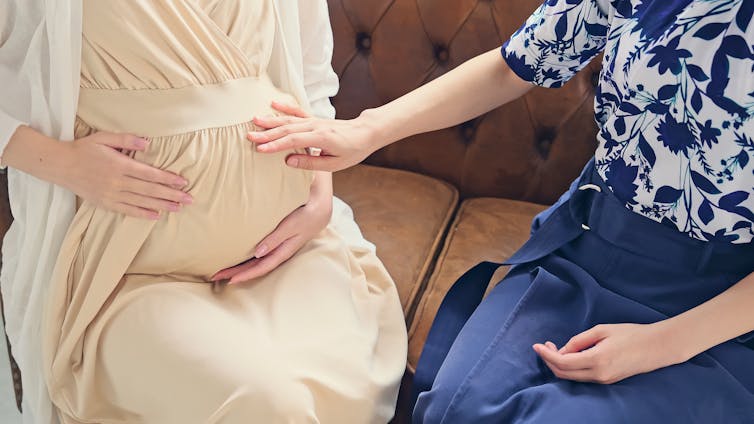Omanyano ovanhu koikundaneki yomalungula kashili paveta, Commisiner Sakaria takunghilile
Veronika Haulenga
Omanyano ovanhu koikundaneki yomalungula kashili paveta, Commisiner Sakaria takunghilile
Veronika Haulenga
Listeners:
Top listeners:
-
play_arrow
Omanyano ovanhu koikundaneki yomalungula kashili paveta, Commisiner Sakaria takunghilile Veronika Haulenga
Artificial wombs could someday be a reality – here’s how they may change our notions of parenthood


Marko Aliaksandr/ Shutterstock
Stephen Wilkinson, Lancaster University; Nicola J. Williams, Lancaster University, and Sara Fovargue, University of Sheffield
Our reproductive lives are considerably different from those of our ancestors, thanks in part to health innovations that have taken place over the past few decades. Practices such as IVF, donor eggs and sperm, womb transplants, surrogacy and egg freezing, mean that for many, there’s now more choice than ever before over whether, when and how to reproduce.
Yet, despite these advances, one aspect of reproduction has remained constant: the need to gestate (grow) foetuses in the womb. But what would happen to our notions of parenthood if technology made it possible to grow a foetus outside the human body?
Until recently, the idea of ectogenesis – growing a foetus outside the body – has been science fiction. But teams in the US, Australia and Japan have begun developing artificial wombs. It’s hoped that this technology will someday save the lives of very premature infants.
Should I have children? The pieces in this series will help you answer this tough question – exploring fertility, climate change, the cost of living and social pressure.
Trials have already been performed on animals – with researchers reporting success in gestating lamb foetuses.
Meanwhile, a team in the Netherlands is developing a similar system using simulation technology. This approach mimics the birth of extremely premature infants using a manikin equipped with advanced monitoring and computer modelling. This allows the researchers to understand how an infant may develop in an environment that simulates the womb’s conditions.
Although this may be many decades away, and is not the intended endpoint of current research, artificial womb technologies could eventually lead to “full ectogenesis” – growing a foetus from conception to “birth” wholly outside the human body.
One barrier to research into full ectogenesis is current legislation worldwide, which either bans embryo research altogether or forbids growing human embryos for research beyond 14 days.
Legislation would therefore need to change for this kind of research to happen. There’s an increasing appetite for this among the international scientific community, but whether such a change would have public support is not known.
Full ectogenesis also raises important ethical, legal and social questions, which would need to be answered before it can be used.
In the UK, the person who gives birth is the child’s legal mother – regardless of genetics or intention. Growing a foetus in an artificial womb could however sever this link between gestation and motherhood.
Surrogacy has, to some extent, already challenged our legal and social conceptions of motherhood. The surrogate is the child’s legal mother at birth, but parenthood can then be transferred to the intended parents via a parental order or adoption.

metamorworks/ Shutterstock
But artificial wombs could disrupt long-established norms in more profound ways, as there would no longer be a “birth mother” at all. The law would need to define who the legal mother is in such circumstances, and whether that definition applies to all mothers or only when artificial womb technologies are used.
The impact of artificial wombs on legal definitions of fatherhood may be less significant.
In the UK, the person who provides the sperm is normally the legal father of the child – unless the child is born using sperm donated in a licensed clinic. In that case, the donor is not the legal father of any resulting child.
But fatherhood (or parenthood for same-sex couples) can also legally be attributed to someone via the Human Fertilisation and Embryology Act 2008. This allows someone not genetically related to the child to be recognised as their legal father or other parent. The provisions in this Act would apply to full ectogenesis because this will require IVF to create the embryo.
Full ectogenesis may result in more radical changes to the way we view legal parenthood. It may cause us not only to rethink our ideas of “mother” and “father”, but also the language used. Would it be more appropriate, for example, to always use the word “parent”, instead?
Personal decisions
Artificial womb technology would also influence the personal decisions that people make about reproduction. It could drastically change the way the decision to become a parent fits into many people’s lives.
Like egg freezing and IVF, artificial wombs would make it possible for women in particular to have children later in life. It could also allow people to gestate multiple foetuses at once – making it possible for them to complete their families within a far shorter time period than has previously been possible.
Artificial womb technology technology would make it easier for more people to have their own biological children – including single men, same sex couples and women unable to become pregnant for health reasons. It would also mean that women would no longer have to undergo the significant risks and burdens associated with pregnancy and childbirth in order to have children.
In science fiction, artificial wombs are often a symbol of dystopia – of technological incursion into natural processes and a means of government control (as in The Matrix or Brave New World). But artificial womb technology might instead add to the reproductive choices currently available – making it possible for more people to become parents if they want to.
Full ectogenesis is still a long way off, but it’s important to discuss it now so that we can have a more informed view of the issues it raises. As with many aspects of human reproduction, artificial womb technology may be divisive.
Some will see it as a way to increase reproductive autonomy and equity, others as dangerous – or even a threat to traditional family structures and values. More still will probably see its potential for both. Whatever your position, this technology could be on the horizon and its implications for society and our concept of parenthood merit careful consideration.![]()
Stephen Wilkinson, Professor of Bioethics, Lancaster University; Nicola J. Williams, Wellcome Lecturer in The Ethics of Human Reproduction, Lancaster University, and Sara Fovargue, Professor of Law, University of Sheffield
This article is republished from The Conversation under a Creative Commons license. Read the original article.
Written by: Contributed
artificial womb bioethics ectogenesis family structures fatherhood Human Fertilisation and Embryology Act 2008 legal implications motherhood parenthood reproductive autonomy reproductive technology societal implications surrogacy
Similar posts
Windhoek Weather
Most popular

Namdia Heist: More questions, lots of confusion

Omuhwahwameki Michael okuunganeka oshikonga shoku patitha oostola dho Rani moshilongo ashihe.

Walvis Bay woman loses over N$777.000 to a fraudster

Don’t let Pohamba’s tears over Nujoma’s death go to waste

Justice Served: Jandre Dippenaar Found Guilty of Six Murders in Swakopmund Court
Copyright 2025 Future Media (Pty) Ltd | Website by Digital Platforms
Tel: +264 83 000 1000 | Email: news@futuremedia.com.na





